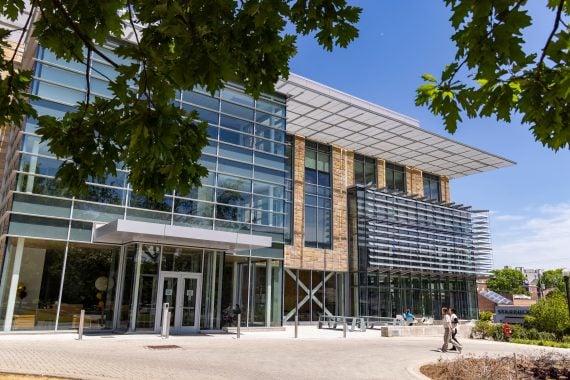There’s been a steady stream of salary and employment data from leading business schools over the past several months as one after another has released 2017 employment reports. We’ve shared a lot of it along the way, including special reports on Kellogg, McDonough, NYU Stern, Tuck, and Stanford. With results from nearly every top school now in, prospective MBA students can take heart that the news is pretty universally encouraging. Overall, data gathered about the Class of 2017 reveal growing salaries across all industries and very high employment rates among graduates from all top institutions.
Taking a look at the reports as a group, we pulled out some key insights we thought our audience might find interesting. Enjoy!
7 Top Takeaways from Leading Business School 2017 Employment Reports
1. More and More MBA Grads Want to Work in Tech
Continuing a trend that has been growing over the past several years, today’s MBA graduates are gaga for the technology industry. Interest is high, of course, in landing jobs at the tech giants like Google, Amazon, Apple, and Facebook. But there’s also ample appetite for startups and smaller firms in everything from fintech to edtech as artificial intelligence (AI), machine learning, blockchain, and cryptocurrency dominate the headlines.
Schools like UC Berkeley’s Haas School of Business and Carnegie Mellon’s Tepper School of Business have been sending more of their grads into tech than any other sector for several years. But now other schools are also seeing tech give more traditional heavyweight MBA consulting and finance recruiters stiff competition. At MIT Sloan School of Management, for example, 31.8 percent of the Class of 2017 went into tech, all but equal to the 32.1 percent who chose consulting. And at Dartmouth’s Tuck School of Business, a record-setting 20 percent of the Class of 2017 took jobs in tech, equal to finance and second only to consulting. At Northwestern’s Kellogg School of Management, one in four graduates—25 percent—headed into tech, up from 22 the year before and 16 the year before that. And at NYU Stern School of Business, technology placements have more than doubled over the past five years. They represented 16.8 percent of all hires last year—up from 10 percent the year before.
2. Amazon’s Appetite for MBAs Knows No Bounds
Tech companies certainly seem to have gotten beyond any reluctance they may have had about hiring business school graduates, and no company has recognized the value of the MBA skill set more than e-commerce giant Amazon. At Stern, Amazon hired more of the school’s grads than any other recruiter—the first time in the school’s history that a tech firm could make that claim. Amazon also swooped in and snapped up more Sloanies (30) than any other company. CMU Tepper and Duke’s Fuqua School also reveal that Amazon is the top hirer of their students. The University of Michigan’s Ross School of Business shares that the Seattle-based tech giant is among the firms hiring more of its students than any other, and Kellogg revealed that Jeff Bezos hired 32 of its 2017 grads to become the third-largest recruiter at that school.
3. Stanford Stuns with Third Consecutive Year of Record-Breaking Salaries
Last year’s Stanford Graduate School of Business (GSB) graduates, now in their first year of post-MBA work, are pulling down an average annual base salary of $144,455—a $4,000 increase over last year’s all-time high. (Median base compensation was $140,000, also besting last year’s by about $4,000.) But it doesn’t stop there. Average signing bonuses, reported by 51 percent of the class, are also up—setting a new school record at $29,534. (Median salary bonuses remained unchanged at $25,000.) And another quarter of the class reported other guaranteed compensation (OGC) surpassing last year’s all-time highs by a whopping $10,000. Average OGC for 2017 grads was $83,065, and median OCG was $50,000. The range was $6,750 to $450,000.
But bucking the trend above, Stanford actually saw fewer of its 2017 grads head into technology than in prior years. Of this most recent graduating class, just 25 percent chose jobs in the tech field, down 8 percentage points from the year before. In what the school called “a rebalancing of the scales among the three top industries,” finance inched up a point to 32 percent, and consulting gained 4 points to 20 percent.
4. Tech Hiring Slips at HBS, but LDPs and Non-Profit/Government Jobs Beckon
Harvard Business School (HBS) also saw fewer of its 2017 graduates opt for tech, 16 percent compared to 19 percent the year before. Instead, more than half of the class headed off to jobs in financial services (31 percent) or consulting (23 percent). The school did note that it saw a “jump in students accepting positions in leadership development programs (LDPs) and general management, with 13 percent of the class going in that direction after graduation.” Grads opting for post-MBA jobs in government or non-profit doubled year over year, from 2 to 4 percent. The Boston school also saw a big jump in what it termed “real-time hiring”—with more than 50 percent of students receiving the offer they ultimately accepted after January of their second year.
5. Wharton Grads Report Record Job Offer Rate
The Wharton School at the University of Pennsylvania trailed both Stanford and Harvard in terms of median base salary, coming in at $130,000 (behind HBS’s $135,000 and the GSB’s $140,000). But its students were more likely to have jobs three months out from graduation. Of those seeking jobs, 97.1 percent of Wharton grads reported offers 90 days out, compared to 95 percent of HBS grads and 92 percent of GSB grads. More Wharton grads—77.2 percent percent—also reported signing bonuses (median bonus, $25,000), compared to 66 percent at HBS (median, $25,000) and 51 percent at Stanford (median, $21,000).
At Wharton, finance and consulting remain the most popular industries, drawing 33 and 28 percent respectively. But increasing numbers of students are going into tech—16 percent in 2017, up from 11.6 percent in 2012.
6. Sloan Students Dig Manufacturing and Tech (and Consulting)
MIT’s Sloan School of Management is the East Coast tech leader, with 31.8 percent of graduates accepting tech firm positions. Amazon was the school’s top recruiter, with Facebook, Cisco, IBM, and Cisco also listed among top hirers. In addition to tech, Sloan students are also drawn to jobs in the manufacturing sector, with 21 percent of graduates choosing that route.
But consulting still holds sway—if just barely. Consulting firms lured 32.1 percent of 2017 grads to stay just ahead of tech firms. McKinsey & Company led the pack, hiring 26 students, followed by Boston Consulting Group (21), Bain (19), and Deloitte (11).
7. West Coast Schools Lead Tech Charge (Surprise)
Berkeley’s Haas School reports one of the highest percentages of graduates pursuing careers in tech, with nearly two in five of grads (38.8 percent) headed into the industry. Fellow Silicon Valley neighbor Stanford is also a big source of tech talent, but as noted above, finance and consulting firms saw a comeback there this year. At Haas, consulting and finance were a distant second and third, drawing 19 and 12 percent respectively.
But the University of Washington’s Foster School of Business trumps all others, with an astounding 58 percent taking the tech route post-MBA. Of course, back east in Pittsburgh, CMU Tepper also sends plenty of grads into tech—43 percent in 2017, up from 34 percent last year. And notably, at Tepper women made up 58 percent of tech-bound grads in the most recent class.
In conclusion, while each institution has its own unique strengths, these business school 2017 employment reports provide clear proof that prospective MBA students can pick and choose between any number of schools no matter their desired career path.
Don’t miss these related articles on current career trends from the Clear Admit archives:
- Best Business Schools to Jumpstart Your Career in Tech—Or Advance It
- Hidden Gems for Top Tech MBAs: Business Schools You Shouldn’t Overlook
- Choosing the Best Business Schools for Consulting
- How to Break Into Consulting at Bain—Tips from the Global Head of Recruiting
- Top MBA Programs for Finance and Investment Banking
- Social Impact MBAs: Programs That Help Students Make a Difference in the World
- Best Business Schools for Social Impact, Part II









